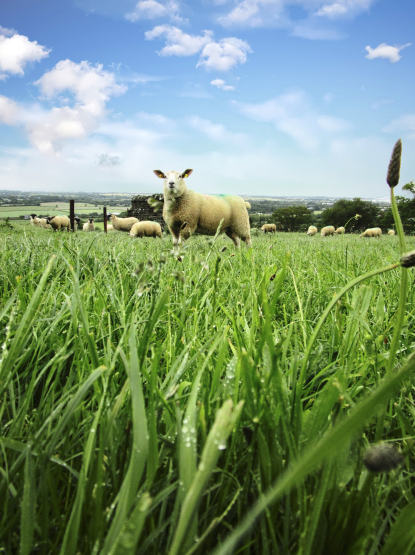Research impact
Environmental and political impact
SmartGrass was the first nationally funded research project to investigate the potential of MSS, with the objective of developing a novel “Low Input – High Output” grassland system. Almost all Irish agricultural grassland research in recent decades has focused on PRG-based “High Input – High Output” systems. Findings from the SmartGrass project, coupled with the team’s ongoing research, have given farmers a way to make their livestock systems more sustainable. In doing so, these findings address environmental policy commitments required from the agricultural sector.
As described above, modelled estimates of nitrous oxide emissions indicated the potential for a very significant reduction by using multispecies swards. Combined with methane reductions associated with earlier animal slaughter, this can make a significant contribution to meeting the 22-30% cut in greenhouse gas emissions required from Irish agriculture by 2030 under the National Climate Action Plan.
The EU’s Farm to Fork Strategy requires countries to reduce reliance on fertilisers by at least 20% by 2030. Findings from the SmartGrass project show this is achievable for grass-based systems. MSS are also a good example of the type of practice change highlighted as necessary in the EU Biodiversity Strategy 2030, to address concerns about the loss of biodiversity due to intensive agricultural practices.
I have been sowing multispecies swards on my milking platform for the last 4 years as a result of meeting Helen and seeing her research at UCD Lyons. MSS are improving my soil health, reducing my N use, they are growing better (for me) during dry periods and are helping (I feel) with animal health.
—Mr Joseph Leonard, dairy farmer and Nuffield Scholar
In 2017, a SmartGrass workshop for policymakers and industry representatives helped move these impacts forward. Consequently, the team’s findings were presented at the Department of Agriculture, Food and the Marine’s (DAFM) symposium on the “Role of Sustainable Grassland in Foodwise 2025”, and were also disseminated to 3,000 of the Department’s personnel via video for Science Week 2018 as “a case study of research having a real impact on DAFM’s policy thinking”.
SmartGrass findings have been highlighted by Minister Ryan during a Dáil debate on Climate Action and Low Carbon Development on 10 June 2020. In addition, the Programme for Government 2020 included a commitment to “encourage better grassland management and support the use of clover and other mixed species in grass reseeding”. The potential of MSS to help mitigate greenhouse gas emissions is recognised in the Climate Change Advisory Council Report 2019 and in the DAFM Ag-Climatise Strategy.
 In 2021, MSS were also included in the DAFM Results Based Environment-Agri Pilot Programme, a scheme which offers farmers financial rewards for farming in a more environmentally friendly way. Furthermore, the Minister for Agriculture, Food and the Marine, Charlie McConalogue TD, announced that financial aid to support farmers planting multispecies swards would be included in the Department’s 2022 budget commitments.
In 2021, MSS were also included in the DAFM Results Based Environment-Agri Pilot Programme, a scheme which offers farmers financial rewards for farming in a more environmentally friendly way. Furthermore, the Minister for Agriculture, Food and the Marine, Charlie McConalogue TD, announced that financial aid to support farmers planting multispecies swards would be included in the Department’s 2022 budget commitments.
Growing interest in MSS is evidenced by the team receiving more than 40 requests for presentations to farmers and industry representatives. The growing interest has translated into an 8-fold increase in MSS seeds sales in 2020-21 compared with the previous 5 years (data from Thomas Moloney of DLF Seeds).
Academic and educational impact
The academic impact of SmartGrass is apparent from the increasing number of large-scale research sites now investigating MSS. Among these, a project called SmartSward continues UCD’s leading role, having been established on the “Long-Term Grazing Platform” at UCD Lyons Farm, a participating site in the Global Farm Platform.
Project team members are now involved in several other projects that build on the work of SmartGrass. These include Green Lamb (on UCD Lyons Farm), FaSTEN (lead by Teagasc) and HeartLand (on the Devenish Lands at Dowth). The latter is a collaboration between Devenish Nutrition, UCD, and the University of Wageningen, Netherlands. Each of these projects will deepen our understanding of MSS and their role in improving the sustainability of livestock production systems. In addition, Teagasc have also recently established MSS at several of their Research Centre Farms.
Two PhDs and one postdoc completed their research on the SmartGrass project. Today there are at least 12 PhD and several more MSc and BAgrSc students engaged in MSS research associated with the team. SmartGrass research also made it onto the honors Leaving Certificate Agricultural Science paper in 2021, which included a question dedicated to MSS. To the best of the team’s knowledge, this is the first time that multispecies sward material has been included in the curriculum.